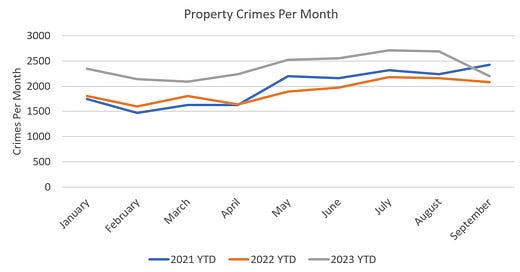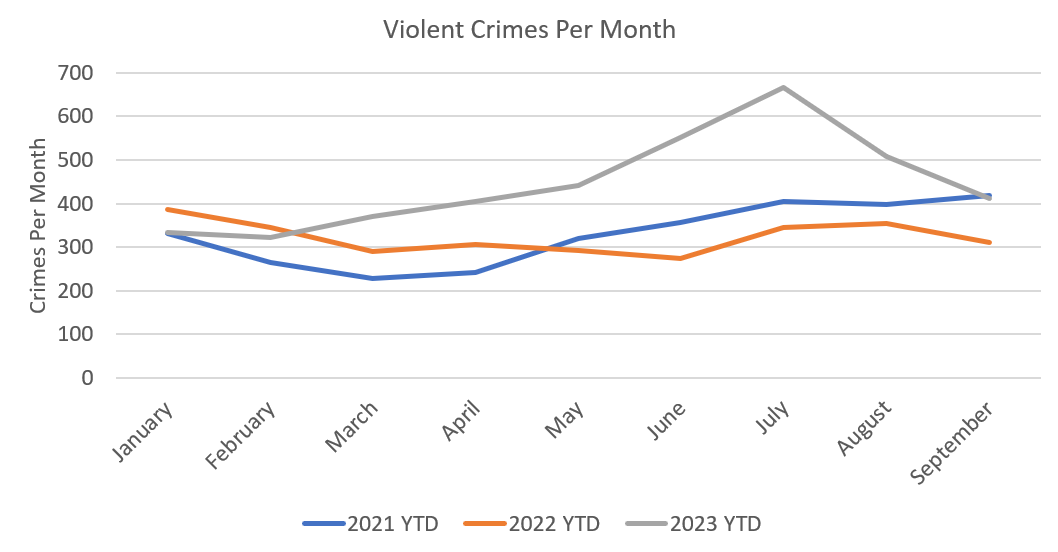Crime in DC fell by 16% from August to September with decreases in all types of crimes and across most wards. This improvement is welcome but crime rates are still higher than previous years. There are some encouraging operational and policy developments that will hopefully help continue this trend of falling crime rates:
Property crimes continue to represent 84% of all crime in DC and fell 15.5%
Violent crime fell 16.2% with decreases in robbery, ADW and homicide
Violent crimes with a gun fell 21%
Despite improvement in September, almost every crime is still up YTD relative to 2022
Overall crime YTD is barely below the pre-COVID baseline with the biggest increases in motor vehicle theft, homicide and robberies
While homicide fell from August’s incredibly high death toll, the homicide rate is still much higher than in 2022. There were 11 more homicides in September 2023 than September 2022 with the largest increase in Ward 8.
Crime fell 15% across DC’s Business Improvement Districts (BIDs)
Every ward saw a decrease in property crime and most wards saw decreases in violent crime:
Homicides fell from 33 in August to 23 in September. Note that this is based on when the homicide happened, not when it was reported to MPD. As a result, the 8 previously-unreported homicides that MPD disclosed in September are counted when they occurred. Ward 8 had a particularly bad month with 12 homicides (7 more than September 2022) and wards 7 and 8 continue to represent a disproportionate share (59%) of DC’s homicides:
Almost every BID saw a decrease in crime with an overall decrease of 15%. This almost exactly matches the overall District-wide decrease of 16%.
This decrease in crime appears to be distinct from “normal” seasonality. Post-COVID we haven’t seen consistent decreases in crime after the Summer so this decrease may reflect other factors. Property crime has been higher in 2023 (the gray line in the graph) than previous years (the blue and oranges lines) for every month except September so hopefully this trend continues:
Violent crime had an enormous Summer spike (which did not happen nearly as much in 2021 or 2022) and is now coming down closer to previous years.
These graphs help illustrate two key takeaways:
2023 is almost certainly going to end with a much higher crime rate than 2022. The crime rate was higher for the vast majority of 2023 so even if DC ends 2023 with below-average crime rates the end-of-year stats will be very negative.
How DC ends the year matters enormously. Small changes in these lines on a graph represent hundreds of people being victimized by crime. So in addition to year to date (YTD) comparisons it’s important to look at monthly trends. Many news stories default to the YTD numbers which are an important frame but they flatten the important distinctions between the Summer violent crime spike and other months.
As always, its very hard to attribute these changes in crime rates to specific factors. It’s always a possibility that these decreases are just “reversion to the mean” after previous increases in crime. It looks like there have been increased efforts at enforcement with rising numbers of juvenile arrests, prosecutions and detentions as I described in this post:
While we don’t have adult arrest data, we do know that United States Attorney’s Office (USAO) prosecutions are up and so is the number of detainees at DC’s jail facilities:
In a press conference Thursday, US Attorney Matthew Graves said that they pressed charges in “a majority” of arrests in Q4 of Fiscal Year (FY)) 2023 (July-August-September). This would be a material increase from FY 2022 where they only charged 33% of arrests. While this would still be a much lower prosecution rate than other cities it is an increase and we have seen an uptick in prosecution volumes:
The detained population at the DC jail has increased from 1,250 in March to 1,588 at the end of September (a 27% increase). Since most of the jail population is made up of people who are detained pre-trial this increase likely reflects an increase in prosecutions of the types of more serious crimes and higher-risk suspects where pretrial detention is more common.
Politically there is a lot of interest in whether the “emergency crime bill” this Summer had any impact on the crime rate. I generally think the impact was probably minimal since these increases in arrests, prosecutions and detention began before the passage of the bill (let alone actual implementation). However proponents of the bill are probably breathing a sigh of relief that the crime stats did fall after the bill passed. In general how DC and our Federal partners enforce the laws on the books seems to have a much bigger real-world impact than the furious debates over “legal gaps” that the Mayor and Council like to fight over.
A great example of this dynamic is “Operation Trident” which Mayor Bowser announced Thursday alongside a phalanx of leaders from Federal agencies. MPD worked with the US Marshals Service, USAO, PSA, CSOSA and the FBI to arrest 48 people who had violated the conditions of their release (pre-trial or post-sentencing) and had active arrest warrants. Usually this was because they had failed to maintain contact with PSA/CSOSA and/or failed to appear for court dates. While Mayor Bowser claimed people committing these types of violations “has been a major concern of ours” many of these kinds of arrest warrants never result in a proactive arrest. The Post story contains this damning quote: “Authorities could not on Thursday directly say why they had not been arresting these alleged violators all along, before a task force was launched.” The representatives from CSOSA and PSA made it clear that while their agencies ask the court for these arrest warrants, they can’t go out and enforce them with an arrest. The CSOSA representative even said "God I hope so" that these kinds of arrests happen more often. Operation Trident reinforces that MPD and our Federal partners could have been doing this all along under current laws. That didn’t stop Mayor Bowser and USA Graves from using the press conference to advocate for their preferred legislative changes and deflect attention away from questions of why it has taken so long to take “enforcing bench warrants” seriously.
There are some other recent developments that give some cause for optimism:
Apparently the Department of Forensic Sciences (DFS) has applied for accreditation for their “chemistry and biology units, which test drugs and DNA.” This would be a positive step in rebuilding DC’s ability to test evidence and unwind some of the serious problems at DFS:
MPD actually grew in September with the October staffing report showing a net gain of 7 officers from the previous month. One month doesn’t come close to making up for years of attrition but it’s a welcome development for those concerned about MPD’s staffing levels. Unfortunately police district 7D (~Ward 8) continued to lose officers:
Thank you for reading and please share this blog with other Washingtonians that are concerned about crime.















Hard to believe. The daily crime report I get seems to show an average 3-6 cars stolen every day.